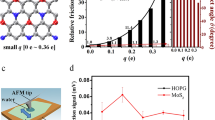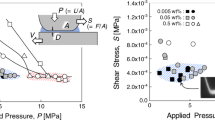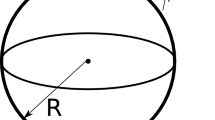Abstract
Direct measurements of the forces acting between polymer surface phases adsorbed at interfaces have only recently been reported1–3. These were carried out in good solvents and showed that repulsive forces were acting between the adsorbed layers; these forces increased monotonically as the surfaces approached each other. In certain conditions, however, for example, those leading to the flocculation of sterically stabilized colloidal systems, one expects the surfaces bearing the adsorbed phases to attract before repelling each other4,5. I have measured the forces acting between two curved mica surfaces immersed in cyclohexane at 24 °C (a worse than θ solvent at this temperature), each bearing a surface layer of adsorbed polystyrene (Mw = 6 × 105). No forces are observed at surface separations larger than about three radii of gyration of the polymer; on closer approach a strong attraction develops between the surfaces, changing to an ultimate repulsion as the surfaces approach closer than about one radius of gyration. Between times of a few minutes and several hours the forces are stable, well behaved and reproducible.
This is a preview of subscription content, access via your institution
Access options
Subscribe to this journal
Receive 51 print issues and online access
$199.00 per year
only $3.90 per issue
Buy this article
- Purchase on Springer Link
- Instant access to full article PDF
Prices may be subject to local taxes which are calculated during checkout
Similar content being viewed by others
References
Lyklema, H. & Van Vliet, T. Faraday Discuss. 65, 25 (1978).
Cain, F. W., Ottewill, R. H. & Smitham, J. B. Faraday Discus. 65, 33 (1978).
Israelachvili, J. N., Tandon, R. K. & White, L. R. Nature 277, 120 (1979); J. Coll. Interface Sci. (in the press).
Vincent, B. Adv. Coll. Sci. 4, 193 (1974).
Flory, P. J. Principles of Polymer Chemistry (Cornell University Press, Ithaca, 1953).
Tabor, D. & Winterton, R. H. S. Proc. R. Soc. A312, 435 (1969).
Israelachvili, J. N. & Tabor, D. Proc. R. Soc. A331, 19 (1972).
Israelachvili, J. N. & Adams, G. E. JCS Faraday I 74, 975 (1978); Nature 262, 774 (1976).
Stromberg, R. R., Tutas, D. J. & Passaglia, E. J. phys. Chem. 69, 3955 (1965).
Schultz, A. R. & Flory, P. J. J. Am. chem. Soc. 74, 4760 (1952).
Outer, P., Carr, C. I. & Zimm, B. H. J. chem. Phys. 18, 830 (1950).
Rowland, F., Bulas, R., Rothstein, E. & Eirich, F. Ind. Eng. Chem. 57, 49 (1965).
Brandrupp, J. & Immergut, E. H. (eds) Polymer Handbook 2nd edn (Wiley, New York, 1975).
Author information
Authors and Affiliations
Rights and permissions
About this article
Cite this article
Klein, J. Forces between mica surfaces bearing layers of adsorbed polystyrene in cyclohexane. Nature 288, 248–250 (1980). https://doi.org/10.1038/288248a0
Received:
Accepted:
Issue Date:
DOI: https://doi.org/10.1038/288248a0
This article is cited by
-
Surface interaction forces mediated by poly(N-isopropylacrylamide) (PNIPAM) polymers: effects of concentration and temperature
Colloid and Polymer Science (2010)
Comments
By submitting a comment you agree to abide by our Terms and Community Guidelines. If you find something abusive or that does not comply with our terms or guidelines please flag it as inappropriate.



